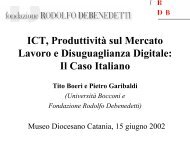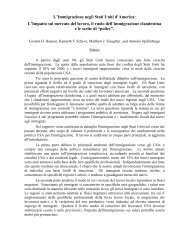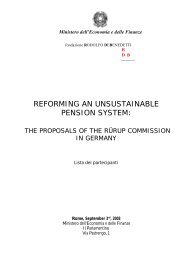The Executive Compensation Controversy - Fondazione Rodolfo ...
The Executive Compensation Controversy - Fondazione Rodolfo ...
The Executive Compensation Controversy - Fondazione Rodolfo ...
You also want an ePaper? Increase the reach of your titles
YUMPU automatically turns print PDFs into web optimized ePapers that Google loves.
THE EXECUTIVE COMPENSATION CONTROVERSY: 24 MAY 2010A TRANSATLANTIC ANALYSIShowever, consistent with expected values if the company grants the same number of optionseach year (as opposed to the same “value” of options each year). Because the grant-dateBlack-Scholes cost of an option is approximately proportional to the level of the stock price,awarding the same number of options after a doubling of stock prices amounts to doublingthe cost of the option award. <strong>The</strong>refore, if the number of options granted stayed constant overtime, the cost of the annual option grants would have risen and fallen in proportion to thechanges in stock prices. But, as shown in Figure 2.9, boards did not award a constant numberof options to employees and executives, but instead increased option grants as stock pricesrose and decreased option grants as stock prices fell – further amplifying the relationshipbetween the opportunity cost of option grants to changes in the level of stock prices.While the evidence in Figure 2.11 is generally supportive Gabaix and Landier (2008)’shypothesis, at least two puzzles remain. First, the relation between CEO compensation andmarket performance ended abruptly in 2002-03, which also coincides with the shift awayfrom options towards restricted stock. Second, as documented in Figure 2.9, the escalation inoption-based compensation was not limited to CEOs but in fact extended down the corporatehierarchy. <strong>The</strong> efficient-contracting explanation for increased equity pay is most relevant toCEOs and other top-level executives who can take direct actions to affect share prices, butnot for lower-level employees. In addition, while the $1 million cap on deductibility mayhave helped trigger larger option grants for top executives, this rule only applied to the topfive executives in each firm and therefore cannot explain the growth in options throughoutthe hierarchy.2.5.3. Perceived CostOur discussion of the evolution of option grants in Section 2.4 suggests an alternativeexplanation for the growth of option-granting in the 1990s (which “explains” the growth inpay): decisions over options are made based on the “perceived cost” of options rather than ontheir economic cost (Murphy (2002), Murphy (2003), Hall and Murphy (2003)). When acompany grants an option to an employee, it bears an economic cost equal to what an outsideinvestor would pay for the option. But, prior to the recent changes in USA accounting rules,it bears no accounting charge and incurs no outlay of cash. Moreover, when the option isexercised, the company (usually) issues a new share to the executive, and receives a taxdeduction for the spread between the stock price and the exercise price. <strong>The</strong>se factors makethe “perceived cost” of an option much lower than the economic cost.-47-









